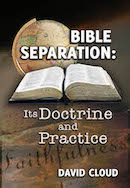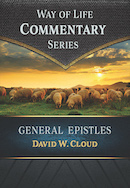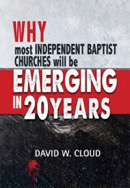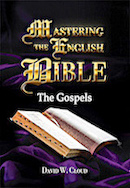866-295-4143, fbns@wayoflife.org
It has been said that “a picture is worth a thousand words,” and I have no doubt that more people have been influenced to believe in evolution by artwork than by words. From its inception, Darwinian evolution has been popularized by art.
Lying art.
THE LAETOLI FOOTPRINTS
Serious natural history museums typically feature a model or photo of the Laetoli footprints that purport to prove that apes walked upright over a million years ago on the evolutionary path toward manhood.
In 1978, footprints discovered at a site called Laetoli in Tanzania by Mary Leakey’s team were announced to be “made by a creature that walked upright in a human manner.”
Two sets of prints ran parallel to one another for a length of about 80 feet. One set of prints is man-sized while the other is much smaller.
The footprints are used as an argument for depicting Australopithecus afarenses’s feet (Lucy) as human-like, in spite of the fossil evidence, and Lucy supporters are dogmatic at this point. Typical of these claims is that by Niles Eldredge and Ian Tattersall,
“Perhaps the most dramatic evidence of the bipedality of this early form is the set of footprints that have been found at Laetoli” (The Myths of Human Evolution, p. 7).
In reply we offer the following points:
1. There is no consensus even among evolutionists about the prints, not only about what creature made them but even how many creatures made them.
The lack of consensus exists even among those who saw the original prints before they were covered up. For example, Ron Clarke believed the footprints were made by one individual and the large size was created by the “hominid’s feet” slipping in the rain-slick ash. Others, as we will see, believe that the tracks were made by humans. Jack Stern and his fellows at Stony Brook believe the prints were left by australopithecines but that the prints show evidence that the creatures were walking in an ape-like manner, transferring their weight along the outside of the foot as opposed to humans who push off with the big toe and thus leave a deep impression of the ball of the foot.
It is obvious that these opinions cannot be proved either way. The issue cannot be settled. All is speculation. The prints are ancient by any standard (meaning they are thousands of years old) and even the original fossil evidence has been destroyed. This great lack of consensus and the deep, serious questions that remain unanswered is typically missing from museum displays. Instead, the Laetoli footprints are presented as straightforward evidence for the evolution of man from apes and more specifically as evidence that “Lucy” walked upright. Invariably the Laetoli footprints are included in the Lucy section of natural history museums.
2. If you remove the evolutionary assumptions, there is very little reason to think that the footprints were made by any creature other than man.
Even Mary Leakey and her team were amazed “at how very human they were” (Ancestral Passions, p. 486).
Tim White, who was involved in excavating the prints, said:
“They are like modern human footprints. If one were left in the sand of a California beach today, and a four-year-old were asked what it was, he would instantly say that someone had walked there. He wouldn’t be able to tell it from a hundred other prints on the beach, nor would you. The external morphology is the same. There is a well-shaped modern heel with a strong arch and a good ball of the foot in front of it. The big toe is straight in line. It doesn’t stick out to the side like an ape toe, or like the big toe in so many drawings you see of Australopithecines in books” (Johanson and Edey, Lucy: The Beginnings of Humankind, p. 250).
Melvin Lubenow says:
“Interpreting the Laetoli footprints is not a question of scholarship; it is a question of logic and the basic rules of evidence. We know what the human foot looks like. There is no evidence that any other creature, past or present, had a foot exactly like the human foot. We also know what human footprints look like. But we will never know for sure what australopithecine footprints look like, because there is no way of associating ‘beyond reasonable doubt’ those extinct creatures with any fossil we might discover” (Bones of Contention, p. 331).
Russell Tuttle of the University of Chicago did an extensive study of habitually unshod people in the mountains of Peru to use in comparison with the Laetoli footprints. He argued that they “resemble those of habitually unshod modern humans” (“The Pitted Pattern of Laetoli Feet,” Natural History, March 1990).
Dr. Duane Gish observes that since footprints of antelopes, pigs, giraffes, elephants, rhinos, hares, ostriches, and other non-extinct animals were also found at Laetoli, that there is no reason to think that the prints were that of anything other than modern man. “In artists’ conceptions of the scene, we see pictures of giraffes for the giraffe footprints, elephants for the elephant footprints, ostriches for the ostrich footprints, etc. And--humans for the human footprints? Oh, no! Occupying the human footprints we see a sub-human creature, half-ape and half-man. While evolutionists concede that a giraffe must have made the giraffe prints, an elephant must have made the elephant prints, etc., their preconceived ideas about evolution and the age of these formations do not allow them to concede that a human made the human prints. Creationists, accepting the plain facts as revealed by the empirical scientific evidence, believe that the prints were made by modern man--Homo sapiens” (The Fossils Still Say No, p. 276).
3. The Lucy creature had ape-like feet and could not therefore have made “modern looking footprints.”
Russell Tuttle has argued that a creature such as Lucy, with long curved toes, could not have left the prints and concludes that “we should shelve the loose assumption that the Laetoli footprints were made by Lucy’s kind” (“The Pitted Pattern of Laetoli Feet,” Natural History, March 1990).
4. The largest footprints are nearly 12 inches long and were made by an individual that was six-feet tall (Virginia Morell, Ancestral Passions, pp. 484, 501).
I put my size 11 shoe alongside the model of the Laetoli prints at the Seattle Science Center and it is obvious that whatever made those prints would have worn an even larger shoe.
But Lucy was only three-feet tall! Did the old girl have such big feet?
5. The uncovering of the footprints was difficult and allowed for errors.
In Lucy’s Child: The Discovery of a Human Ancestor, Donald Johanson describes the process as related to him by Tim White who was a member of Mary Leakey’s team at the time of the discovery.
“[Tim explained] ‘The footprints had been made in one layer of ash. But they had made a dent in the thin ash layers underlying them too. The farther down you went from the actual print, however, the more deformed the impression would be. So we first had to be absolutely sure that we did not puncture through that primary surface--or else we’d end up with only a distorted image. Luckily, there was a thin skin of calcium carbonate lying right over the footprint layer, just a little harder than the light gray ash that fell later and filled in the depressions. I poured paint thinner onto the print, and while the gray infilling soaked it up and darkened, the calcium carbonate skin didn’t. In that way I was able to discriminate by color between the two ash layers, and carefully remove the infilling without working down into the print itself” (Lucy’s Child, p. 189).
After Tim White left, Mary Leakey continued uncovering the footprints with “a mallet and a chisellike probe,” a much clumsier technique that gave greater room for distorting the prints and left chisel marks in them. White says,
“Although I saw she had dug through the calcareous lining of the print and advised her to stop, she did not heed my advice” (Lucy’s Child, p. 192).
It has since become a consensus that Mary’s chiselling defaced at least one of the footprints (p. 193).
6. The footprints are gone and we cannot be certain that the casts give an accurate picture.
In an effort to preserve the prints, Mary Leakey had the site covered with layers of sand, plastic sheeting, and lava boulders. In spite of this, or perhaps because of it, the site was quickly grown over. By 1985, seven years after the discovery, there were acacia trees growing over the buried prints, some of them eight feet tall (Mary’s Child, p. 191).
Further, Tim White claims that the casts do not give a true impression of the original prints.
In 1985 he told Donald Johanson,
“For all that’s been written about these prints, only a tiny handful of experts actually had a chance to see them before they were shoveled over. I was one. Ron Clarke was another. Most everybody else who talks about their meanings and implications is talking from casts, not originals. And that’s a real shame. A cast can’t tell you anything about texture, about color, about the fine details of the original. It doesn’t tell you the difference between the actually foot print and the distorted image below it. It doesn’t tell you whether some swelling in the print is part of the morphology of an ancient foot, or just a bit of unexcavated infilling” (Lucy’s Child, p. 191).
In light of this great uncertainty and confusion, to use the Laetoli footprints as an icon of human evolutionary descent from ape is criminal.
7. In fact, the Laetoli footprints are actually an icon of creation.
If the evolutionary assumptions are removed, the Laetoli footprints are powerful evidence that “modern man” lived at the same time as creatures that are supposedly millions of years old. Either this means that the evolutionary dating methods are wrong and the entire fossil strata concept should be discarded, or it means that “modern man” is millions of years old. Either way, the Laetoli footprints disprove standard evolutionary thinking.
- Receive these reports by email
- www.wayoflife.org
______________________
Sharing Policy: Much of our material is available for free, such as the hundreds of articles at the Way of Life web site. Other items we sell to help fund our expensive literature and foreign church planting ministries. Way of Life's content falls into two categories: sharable and non-sharable. Things that we encourage you to share include the audio sermons, O Timothy magazine, FBIS articles, and the free eVideos and free eBooks. You are welcome to make copies of these at your own expense and share them with friends and family. You may also post parts of reports and/or entire reports to websites, blogs, etc as long as you give proper credit (citation). A link to the original report is very much appreciated as the reports are frequently updated and/or expanded. Things we do not want copied and distributed are "Store" items like the Fundamental Baptist Digital Library, print editions of our books, electronic editions of the books that we sell, the videos that we sell, etc. The items have taken years to produce at enormous expense in time and money, and we use the income from sales to help fund the ministry. We trust that your Christian honesty will preserve the integrity of this policy. "For the scripture saith, Thou shalt not muzzle the ox that treadeth out the corn. And, The labourer is worthy of his reward" (1 Timothy 5:18). Questions? support@wayoflife.org
Goal:Distributed by Way of Life Literature Inc., the Fundamental Baptist Information Service is an e-mail posting for Bible-believing Christians. Established in 1974, Way of Life Literature is a fundamental Baptist preaching and publishing ministry based in Bethel Baptist Church, London, Ontario, of which Wilbert Unger is the founding Pastor. Brother Cloud lives in South Asia where he has been a church planting missionary since 1979. Our primary goal with the FBIS is to provide material to assist preachers in the edification and protection of the churches.
Offering: Offerings are welcome if you care to make one. If you have been helped and/or blessed by our material offerings can be mailed or made online with with Visa, Mastercard, Discover, or Paypal. For information see: www.wayoflife.org/about/makeanoffering.html.





